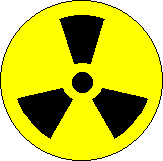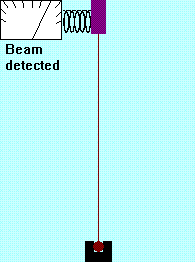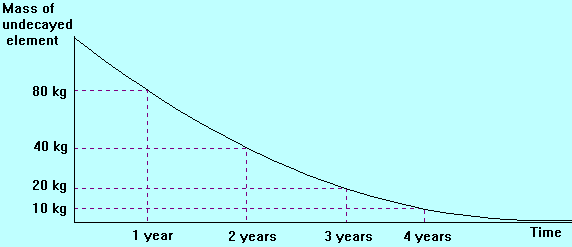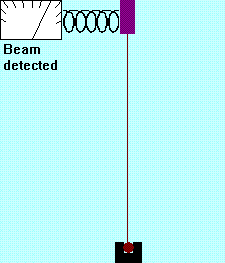
Radioactivity
In the nineteenth century, Henri Becquerel accidentally put a piece of uranium ore on top of a metal key on a photographic plate in a draw. When he examined the photographic plate a few days later, he found that it had gone completely foggy except for the part which was underneath the key. 
Becquerel conlcuded that there were some sort of rays coming off the uranium which were ruining the photograph, but that the key was blocking these rays. He had discovered radioactivity. In the next few years, the nature of radioactivity was sorted out. Scientists like Marie Curie and her husband Pierre worked hard to isolate other radioactive elements such as Polonium and Radium. Knowledge of radioactivity helped scientists to work out the structure of atoms. 
To date, about 20 radioactive elements have been discovered, all beyond Lead at the bottom of the periodic table. It is thought that these atoms are unstable because their nuclei are so large - like a pile of bricks toppling over when it gets too high. In addition to these large atoms, there are also various isotopes of smaller atoms which are also radioactive. Radioactive atoms break down into smaller pieces through radioactive decay. All radioactive decay involves particles or rays emerging from the nucleus. The orbiting electrons are not involved in radioactive decay at all. Since the identity of the atom (which element it is) depends on how many protons are in the nucleus, radioactive decay often means the atom changes from one element to another. The new atom may also be radioactive, so one atom may go through several different elements before becoming stable. Alpha particles
A common type of radiation is alpha radiation. An alpha particle (symbol α) consists of two protons and two neutrons, which is the same as the nucleus of a Helium atom. The alpha particles often pick up stray electrons to become proper Helium atoms. Indeed, one way to detect when a substance is an alpha-emitter (giving off alpha particles) is the slight trace of helium. Helium is so light that it floats out of the Earth's atmosphere, so all Helium discovered on Earth results from alpha decay. When an atom gives off an alpha particle, the number of protons goes down by 2 and the number of particles in the nucleus goes down by 4. This turns the atom into another element. Here are two examples of alpha decay:
(The upper figure in each case is the Relative Atomic Mass, i.e. how many protons and neutrons the nucleus contains. The lower figure in each case is the Atomic Number, i.e. how many protons are in the nucleus). 
Since alpha particles are positively charged, they are deflected by electrical and magnetic fields. Alpha particles are attracted to the negative terminal of electric fields, as opposite charges attract. Radioactive particles are detected by a device called a Geiger counter. The diagram on the left shows a source of alpha particles (an "alpha emitter") which has been placed in a lead box with a hole in it, so that only a thin beam of alpha particles emerges. The purple rectangle at the top of the image represents a Geiger counter. Click on the Field On/Off button below to switch the electric field on or off. Then use the mouse to drag the Geiger counter right or left to track the moving particle beam. Beta particlesAnother type of radiation is slightly more puzzling than alpha radiation. It was discovered that some types of atoms emitted electrons moving at almost the speed of light from their nucleus. Electrons weren't supposed to exist in the nucleus! This mysterious radioactivity was called Beta radiation (symbol β). Eventually, it was discovered that beta decay happened when a neutron inside the nucleus decayed to form a proton and ejected a high-speed electron.  When an atom decays through Beta emission, a proton is created at the expense of a neutron. This means that the atomic number (the number of protons) increases by 1, but the mass does not change, since the electron ejected has virtually no mass. Thorium-234 decays through Beta emission to form Protactinium-234. This decays in turn through Beta emission to form an isotope of Uranium called Uranium-234. You notice that although two electrons have been ejected, the mass remains the same throughout.
Since beta particles are electrons, they carry a negative charge and so are deflected by electrical and magnetic fields. When placed in an electrical field, beta particles deflect towards the positive terminal as opposite charges attract. The beam does not deflect as much as a beam of alpha particles would. Even though beta particles are less massive than alpha particles, they travel so quickly that very little deflection is possible. Click on the purple Geiger counter in the image to the left to move it right and left. Again, there is a Field On/Off button below so that you can turn the electric field on and off. Beta particles are more powerful than alpha particles. They are blocked by a few centimetres of aluminium or several metres of air. Gamma RaysThe third common type of radiation is the easiest to understand. Gamma rays are a type of electromagnetic rays, similar to light and X-rays. They are the most powerful type of electromagnetic ray known, being at the extreme high-frequency end of the electromagnetic spectrum. A gamma ray (symbol γ) represents the atom "cooling off". It does not alter the mass or atomic number of the atom in any way. Gamma rays are very powerful, being able to penetrate several centimetres of lead! A great thickness of lead is needed to block them completely. Elements which give off gamma rays often give off other types of radiation as well! Alpha, beta and gamma radiation are the three most common types of radiation, but there are others, for instance, neutron emission. Alpha, Beta and Gamma emission summarised!
Half Life Radioactive atoms do not all decay at the same time but randomly. Each atom is like a tiny bomb with a fuse of random length. Initially, when there is a large number of atoms, a great many of them decay. Later, as the number of undecayed atoms goes down, the number that decay in any second also goes down. This gives the amount of radioactive material the curve shape shown above. You can see the number of radioactive atoms initially drops off quickly, then gradually slows down.  Even though atoms decay randomly, because there are billions of atoms present, their overall behaviour follows a mathematical pattern. Each element has a time period called the Half Life, which is the time taken for half the element to decay. After one half life, half the element is left. After another, a quarter is left. After another, one eighth is left etc. Half lives vary from thousands of years (Uranium) to fractions of a seconds (Beryllium-5). The time period is a particular number for each radioactive element, and depends on various things such as the forces holding the nucleus of those atoms together. Please note that different isotopes of the same element may have different half lives. For instance, the half life of Uranium-235 is different from that of Uranium-238! Here's an example. Let's suppose that the half life of some element X is exactly 80 days. If you carefully purified 100g of element X, then 80 days later you would have 50g of X mixed together with 50g of whatever X decayed into. The material would still weigh 100g, but only 50g of it would be X. Then, after another 80 days, only 25g of the material would be X, and after another 80 days (that's 240 days from when you purified it!), only 12.5g would be X. In theory, the proportion of the material that is element X never drops to 0, but after a few years, the amount of element X in the sample would be so small that it would be undetectable, and we would say that the element had completely decayed.
Nuclear FissionThe types of radioactivity discussed up to now have occured as a result of natural decay. It is possible to split a uranium atom into two parts by hitting the nucleus with a neutron. The atom splits into two sub-nuclei, Krypton and Xenon and produces three more neutrons that fly off and may hit other uranium atoms. The splitting of uranium is called fission. As well as all the sub-atomic particles, it also produces high energy gamma rays. This is why uranium is used in atomic bombs and nuclear power stations. Click on Bang to see it happen. Most of the neutrons produced in uranium fission leave the uranium block without hitting any other nuclei. However, a small proportion hit other nuclei and start the process off again. If enough atoms do this, then a chain reaction builds up. |



 Go back
Go back